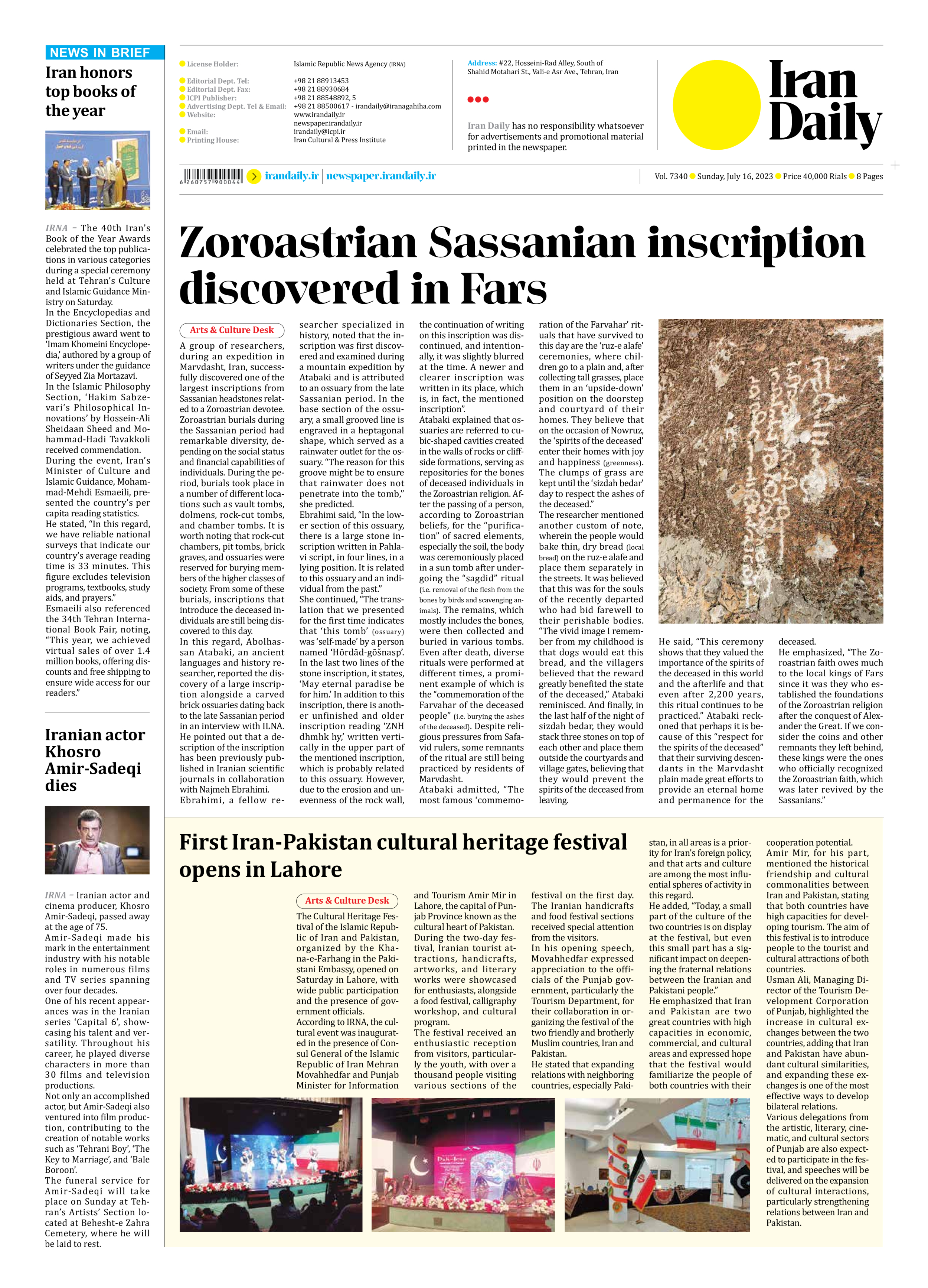
Zoroastrian Sassanian inscription discovered in Fars
A group of researchers, during an expedition in Marvdasht, Iran, successfully discovered one of the largest inscriptions from Sassanian headstones related to a Zoroastrian devotee.
Zoroastrian burials during the Sassanian period had remarkable diversity, depending on the social status and financial capabilities of individuals. During the period, burials took place in a number of different locations such as vault tombs, dolmens, rock-cut tombs, and chamber tombs. It is worth noting that rock-cut chambers, pit tombs, brick graves, and ossuaries were reserved for burying members of the higher classes of society. From some of these burials, inscriptions that introduce the deceased individuals are still being discovered to this day.
In this regard, Abolhassan Atabaki, an ancient languages and history researcher, reported the discovery of a large inscription alongside a carved brick ossuaries dating back to the late Sassanian period in an interview with ILNA. He pointed out that a description of the inscription has been previously published in Iranian scientific journals in collaboration with Najmeh Ebrahimi.
Ebrahimi, a fellow researcher specialized in history, noted that the inscription was first discovered and examined during a mountain expedition by Atabaki and is attributed to an ossuary from the late Sassanian period. In the base section of the ossuary, a small grooved line is engraved in a heptagonal shape, which served as a rainwater outlet for the ossuary. “The reason for this groove might be to ensure that rainwater does not penetrate into the tomb,” she predicted.
Ebrahimi said, “In the lower section of this ossuary, there is a large stone inscription written in Pahlavi script, in four lines, in a lying position. It is related to this ossuary and an individual from the past.”
She continued, “The translation that we presented for the first time indicates that ‘this tomb’ (ossuary) was ‘self-made’ by a person named ‘Hōrdād-gōšnasp’. In the last two lines of the stone inscription, it states, ‘May eternal paradise be for him.’ In addition to this inscription, there is another unfinished and older inscription reading ‘ZNH dhmhk hy,’ written vertically in the upper part of the mentioned inscription, which is probably related to this ossuary. However, due to the erosion and unevenness of the rock wall, the continuation of writing on this inscription was discontinued, and intentionally, it was slightly blurred at the time. A newer and clearer inscription was written in its place, which is, in fact, the mentioned inscription”.
Atabaki explained that ossuaries are referred to cubic-shaped cavities created in the walls of rocks or cliff-side formations, serving as repositories for the bones of deceased individuals in the Zoroastrian religion. After the passing of a person, according to Zoroastrian beliefs, for the “purification” of sacred elements, especially the soil, the body was ceremoniously placed in a sun tomb after undergoing the “sagdid” ritual (i.e. removal of the flesh from the bones by birds and scavenging animals). The remains, which mostly includes the bones, were then collected and buried in various tombs. Even after death, diverse rituals were performed at different times, a prominent example of which is the “commemoration of the Farvahar of the deceased people” (i.e. burying the ashes of the deceased). Despite religious pressures from Safavid rulers, some remnants of the ritual are still being practiced by residents of Marvdasht.
Atabaki admitted, “The most famous ‘commemoration of the Farvahar’ rituals that have survived to this day are the ‘ruz-e alafe’ ceremonies, where children go to a plain and, after collecting tall grasses, place them in an ‘upside-down’ position on the doorstep and courtyard of their homes. They believe that on the occasion of Nowruz, the ‘spirits of the deceased’ enter their homes with joy and happiness (greenness). The clumps of grass are kept until the ‘sizdah bedar’ day to respect the ashes of the deceased.”
The researcher mentioned another custom of note, wherein the people would bake thin, dry bread (local bread) on the ruz-e alafe and place them separately in the streets. It was believed that this was for the souls of the recently departed who had bid farewell to their perishable bodies. “The vivid image I remember from my childhood is that dogs would eat this bread, and the villagers believed that the reward greatly benefited the state of the deceased,” Atabaki reminisced. And finally, in the last half of the night of sizdah bedar, they would stack three stones on top of each other and place them outside the courtyards and village gates, believing that they would prevent the spirits of the deceased from leaving.
He said, “This ceremony shows that they valued the importance of the spirits of the deceased in this world and the afterlife and that even after 2,200 years, this ritual continues to be practiced.” Atabaki reckoned that perhaps it is because of this “respect for the spirits of the deceased” that their surviving descendants in the Marvdasht plain made great efforts to provide an eternal home and permanence for the deceased.
He emphasized, “The Zoroastrian faith owes much to the local kings of Fars since it was they who established the foundations of the Zoroastrian religion after the conquest of Alexander the Great. If we consider the coins and other remnants they left behind, these kings were the ones who officially recognized the Zoroastrian faith, which was later revived by the Sassanians.”







